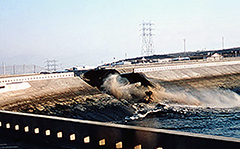Baldwin Hills Dam Disaster
The Baldwin Hills Dam disaster occurred on December 14, 1963, when the dam containing the Baldwin Hills Reservoir suffered a catastrophic failure and flooded the residential neighborhoods surrounding it. It began with signs of lining failure, followed by increasingly serious leakage through the dam at its east abutment. After three hours the dam breached, with a total release of 250 million US gallons (950,000 m3), resulting in five deaths and the destruction of 277 homes. Vigorous rescue efforts averted a greater loss of life.
The reservoir was located on a low hilltop in Baldwin Hills, Los Angeles, California. It was constructed between 1947 and 1951 by the Los Angeles Department of Water and Power directly on an active fault line, which was subsidiary to the well known nearby Newport–Inglewood Fault. The underlying geologic strata were considered unstable for a reservoir, and the design called for a compacted soil lining meant to prevent seepage into the foundation. The fault lines were considered during planning but were deemed by some, although not all, of the engineers and geologists involved as not significant.
The former reservoir is now part of the Kenneth Hahn State Recreation Area. More details
The reservoir was located on a low hilltop in Baldwin Hills, Los Angeles, California. It was constructed between 1947 and 1951 by the Los Angeles Department of Water and Power directly on an active fault line, which was subsidiary to the well known nearby Newport–Inglewood Fault. The underlying geologic strata were considered unstable for a reservoir, and the design called for a compacted soil lining meant to prevent seepage into the foundation. The fault lines were considered during planning but were deemed by some, although not all, of the engineers and geologists involved as not significant.
The former reservoir is now part of the Kenneth Hahn State Recreation Area. More details

